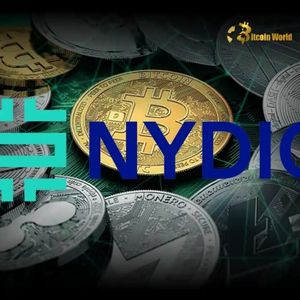BitcoinWorld Bitcoin vs Altcoins: NYDIG Executive Issues Crucial Warning on Corporate Crypto Holdings In the evolving landscape of digital assets, companies are increasingly exploring the potential of adding cryptocurrencies to their corporate treasuries. While the adoption curve continues its upward trajectory, a recent warning from a prominent figure in the Bitcoin financial services space serves as a critical reminder: not all cryptocurrencies are created equal, especially when it comes to long-term corporate asset holdings. Greg Cipolaro, the global head of research at NYDIG, a leading Bitcoin-focused firm, has voiced concerns about companies managing cryptocurrencies other than Bitcoin as core corporate assets, urging a cautious approach. This perspective underscores a fundamental debate in the crypto world: the significant differences between Bitcoin and the vast universe of altcoins. Understanding the Core Debate: Bitcoin vs Altcoins Greg Cipolaro’s warning, highlighted in a recent NYDIG report, centers on the distinct characteristics of Bitcoin compared to the majority of other digital assets, often referred to as altcoins. He posits that while more companies are indeed boosting their crypto reserves, a crucial distinction must be made regarding the nature of the assets being held. Cipolaro suggests that many cryptocurrencies beyond Bitcoin function more like ‘consumptive commodities.’ What does this mean in practical terms? Bitcoin (BTC): Often viewed as digital gold, a store of value, or a long-term investment asset due to its fixed supply, decentralized nature, and robust network effect built over more than a decade. Its primary use case for corporate treasuries is often capital preservation or a hedge against inflation and currency debasement. Altcoins (e.g., Ethereum, Solana, Cardano, etc.): While many have specific use cases (smart contracts, decentralized finance, NFTs, supply chain management, etc.), Cipolaro’s ‘consumptive commodity’ label implies that their value might be more tied to their utility within a specific ecosystem or application, rather than inherent scarcity or status as a foundational monetary layer. Their long-term value proposition for a corporate treasury holding could be less clear without widespread, sustained adoption of their specific function. This distinction is not merely academic; it has significant implications for how a company might approach holding these assets on its balance sheet. The Rise of the Corporate Crypto Treasury Over the past few years, we’ve seen a notable trend: publicly traded and private companies allocating a portion of their treasury reserves to cryptocurrencies. Pioneered by companies like MicroStrategy, this movement was initially heavily focused on Bitcoin. The rationale often included: Hedging against inflation. Potential for significant appreciation. Holding a reserve asset outside the traditional financial system. Attracting investor interest. However, as the crypto market matured and altcoins gained prominence, some companies began to explore diversification into assets beyond Bitcoin. This is where NYDIG’s warning becomes particularly relevant. Holding a corporate treasury is fundamentally different from a speculative individual investment. Corporate assets are subject to stringent accounting rules, regulatory scrutiny, and the need for clear long-term strategic alignment. Cipolaro’s concern is that while the trend of increasing crypto holdings is real, the underlying value proposition of many altcoins as enduring corporate assets, absent widespread and persistent adoption of their specific networks or use cases, remains questionable for a corporate treasury context. Navigating the Altcoin Investment Risk What specific risks might NYDIG and Greg Cipolaro be highlighting when discussing altcoins as corporate treasury assets? The ‘consumptive commodity’ analogy suggests several potential challenges: Dependence on Adoption: The value of many altcoins is intrinsically linked to the success and adoption of the specific blockchain or protocol they power. If that network fails to gain traction, faces technical issues, or is superseded by competitors, the value of the token could plummet. Regulatory Uncertainty: The regulatory landscape for cryptocurrencies is still evolving globally. While Bitcoin’s status as a commodity is relatively more accepted in some jurisdictions, the classification of many altcoins remains ambiguous. Some could potentially be deemed securities, which would introduce significant compliance burdens and legal risks for corporate holders. Competitive Landscape: The altcoin space is highly competitive. New protocols and tokens emerge constantly, potentially displacing existing ones. The long-term dominance or even survival of many altcoins is not guaranteed. Lack of Clear Use Case for Treasury: While an altcoin might be essential for interacting with a specific decentralized application (DApp) or network, its utility as a simple store of value or a hedge for a corporate balance sheet might be limited compared to Bitcoin. Volatility: While all crypto assets are volatile, many altcoins, especially those with smaller market caps or newer protocols, can experience even more extreme price swings, making them potentially less suitable for a conservative treasury strategy. These factors contribute to a higher degree of uncertainty and potential Altcoin Investment Risk when considering them for a corporate balance sheet, compared to the relatively more established narrative and infrastructure surrounding Bitcoin. The Uneven Path of Institutional Crypto Adoption Cipolaro also touched upon the differing levels of acceptance within traditional finance (TradFi). He noted that Bitcoin has gradually gained acceptance on Wall Street over the years. We’ve seen: The launch of Bitcoin futures and options. Increased participation from hedge funds and asset managers. The recent approval and success of spot Bitcoin ETFs in the United States. Major financial institutions offering Bitcoin-related services to clients. This growing infrastructure and regulatory clarity around Bitcoin have paved a smoother path for Institutional Crypto Adoption . Bitcoin is increasingly being discussed and treated as a legitimate asset class within established financial circles. In contrast, Cipolaro points out that TradFi is ‘still warming up’ to the second-largest cryptocurrency, Ethereum (ETH), let alone the thousands of other altcoins. While Ethereum has made significant strides, particularly with its transition to Proof-of-Stake and its central role in DeFi and NFTs, the institutional products and regulatory frameworks surrounding it (and other altcoins) are generally less developed or more complex than those for Bitcoin. This disparity in institutional acceptance and the availability of regulated investment products further reinforces the difference in maturity and perceived risk between Bitcoin and the broader altcoin market from a traditional finance and corporate treasury perspective. What Does This Mean for Your Corporate Crypto Strategy ? NYDIG’s warning is not necessarily a blanket dismissal of all altcoins for all purposes. Many altcoins represent innovative technologies and exciting investment opportunities for individuals or venture capital. However, for a company considering holding crypto on its balance sheet, Cipolaro’s points highlight the need for a highly cautious and differentiated approach. Here are some actionable insights for companies developing or reviewing their Corporate Crypto Strategy : Define Your Objectives: Why are you holding crypto? Is it for long-term capital preservation, potential growth, transactional purposes, or something else? Your objectives should dictate the assets you consider. Understand the Asset’s Nature: Don’t treat all crypto equally. Research the fundamental technology, use case, tokenomics, regulatory risks, and competitive landscape of each asset. Is it primarily a store of value, a utility token, a governance token, or something else? Prioritize Due Diligence: Just as you would with any traditional asset, conduct thorough due diligence. Consider the project team, community support, security audits, and future development roadmap. Assess Regulatory Risk: Be acutely aware of the regulatory status of the asset in your jurisdiction and others where you operate. Avoid assets with significant regulatory uncertainty if your priority is treasury management. Consider Liquidity and Infrastructure: For corporate holdings, ease of acquisition, custody, and potential liquidation is crucial. Bitcoin generally has the deepest liquidity and most developed institutional-grade infrastructure. Start Simple, Expand Cautiously: Many companies begin their crypto treasury journey with Bitcoin due to its maturity and institutional acceptance. Diversifying into altcoins should involve a much higher degree of scrutiny and a clear understanding of the specific risks involved. Holding altcoins as corporate assets requires a level of expertise and risk tolerance that may exceed that required for holding Bitcoin. It’s essential to consult with financial, legal, and tax professionals experienced in digital assets. Conclusion: Prudence in the Digital Treasury Greg Cipolaro’s insights from NYDIG serve as a timely reminder that while the corporate adoption of crypto is growing, a nuanced understanding of the underlying assets is paramount. The fundamental differences between Bitcoin and the vast majority of altcoins, particularly concerning their long-term value proposition as non-consumptive, universally accepted stores of value, are significant for corporate treasuries. While altcoins may offer exciting technological innovation and potential growth, their classification as ‘consumptive commodities’ by some experts highlights the inherent risks related to adoption dependency, regulatory uncertainty, and market competition. Bitcoin, with its established narrative as digital gold and increasing institutional acceptance, currently occupies a distinct category in the eyes of many traditional finance participants and Bitcoin-focused firms like NYDIG. Companies exploring or expanding their crypto holdings must move beyond treating ‘crypto’ as a monolithic asset class. A robust Corporate Crypto Strategy requires careful consideration of each asset’s unique characteristics, potential risks, and alignment with the company’s financial objectives and risk tolerance. Prudence, thorough research, and a clear understanding of the Altcoin Investment Risk are essential for navigating the complexities of the digital asset landscape. To learn more about the latest Bitcoin vs Altcoins trends, explore our article on key developments shaping Corporate Crypto Treasury Institutional Crypto Adoption. This post Bitcoin vs Altcoins: NYDIG Executive Issues Crucial Warning on Corporate Crypto Holdings first appeared on BitcoinWorld and is written by Editorial Team
















